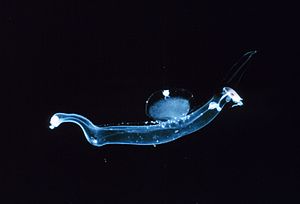Pterotracheoidea
| Pterotracheoidea | ||||||||||||
|---|---|---|---|---|---|---|---|---|---|---|---|---|

Pelagic snail of the family Pterotracheidae . |
||||||||||||
| Systematics | ||||||||||||
|
||||||||||||
| Scientific name | ||||||||||||
| Pterotracheoidea | ||||||||||||
| Rafinesque-Schmaltz , 1840 |
The keelfoot or pterotracheoidea are a superfamily of snails that have a pelagic way of life. All forms are predatory. They used to have the status of an order and were referred to as heteropods or heteropods . The oldest representatives of the Pterotracheoidea are known from the Lower Jura ( Toarcium ).
features
The group includes very large (approx. 50 cm) to small forms (approx. 1 cm). The soft body is gelatinous and translucent. The animals swim on their backs with the help of the foot that has been transformed into a fin. The case, if still present, is thin and fragile; it is even completely regressed in a family. The original, housing-supporting forms can even retract completely into the housing.
In adaptation to the pelagic way of life, the snails have lens eyes with a large, spherical lens and a ribbon-shaped retina. The mouth sits at the end of a movable trunk-shaped extension of the head ( proboscis ). The radula has elongated, sickle-shaped teeth on the edge, which are used to catch prey.
The animals are of separate sex. The males use a long penis to transfer the packets of seeds into the female's mantle cavity. The development takes place via a plankton-eating Veliger larva. The larva forms a larval housing that can be closed with an operculum. In the species of the family, the larval housing and operculum are shed during metamorphosis. The species of the Carinariidae keep the housing, but shed the operculum. In the species of the Atlantidae family, the housing and operculum are retained for life.
Lifestyle and diet
The representatives of the superfamily live pelagic and feed predatory on other animals of the plankton (or nectons ). The prey animals are either cut up with the radula or devoured as a whole.
Occurrence
The species of the superfamily live worldwide in the upper 200 meters of the warmer seas. They are usually not very common.
Systematics
There are currently three families in this superfamily:
- Pterotracheidae Rafinesque-Schmaltz, 1814
- Carinariidae Blainville, 1818
- Atlantidae Rank, 1829
Jean-Baptiste de Lamarck described the group in 1812 under the name Heteropoda as the fifth of five sections within the order of "head-bearing mollusks". For a long time they were scientifically referred to as the order within snails. Since it has now been downgraded to a superfamily and only genus-based names are permitted for superfamilies, only the name Pterotracheoidea given by Constantine S. Rafinesque-Schmaltz in 1814 is valid today . Another commonly used synonym is Carinarioidea. The name Heteropoda is now only valid for one genus of giant crab spiders .
literature
- Rudolf Leuckart : The construction of the heteropods . In: Zoological investigations by Dr. Rudolf Leuckart, third volume: Heteropods, hermaphrodites, heterocotylifers. Ricker, Giessen 1854. pp. 1-68.
- Carl Gegenbaur : Investigations into pteropods and heteropods: a contribution to the anatomy and development history of these animals . Engelmann, Leipzig 1855. Heteropoden, pp. 105-185.
- Johan Jacob Tesch : Systematic review of all dead nu toe known heteropods . EJ Brill, Leiden 1906.
- Johan Jacob Tesch: Heteropoda . AF Høst, København 1949.
- Philippe Bouchet & Jean-Pierre Rocroi: Part 2. Working classification of the Gastropoda . Malacologia, 47: 239-283, Ann Arbor 2005 ISSN 0076-2997
- Victor Millard: Classification of the Mollusca. A Classification of World Wide Mollusca . Rhine Road, South Africa 1997 ISBN 0-620-21261-6
- Winston Ponder & David Lindberg, Towards a phylogeny of gastropod molluscs; an analysis using morphological characters . Zoological Journal of the Linnean Society, 119: 83-265, London 1997 ISSN 0024-4082
Individual evidence
- ^ Brockhaus' little conversation lexicon, 1911
- ^ Jean Baptiste Pierre Antoine de Monet de Lamarck: Extrait du cours de zoologie du Muséum d'histoire naturelle, sur les animaux sans vertèbres . Paris 1812. p. 124. Les Mollusques Céphalés, 5 e section. Mollusques Hétéropodes. Point de bras en couronne sur la tete; point de pied sur le ventre ou sous la gorge pour ramper. Une ou plusieurs nageoires, sans ordre régulier, et non disposées par paires. Corps libre, allongé, nageant horizontalement. Tête distincte; deux yeux.
